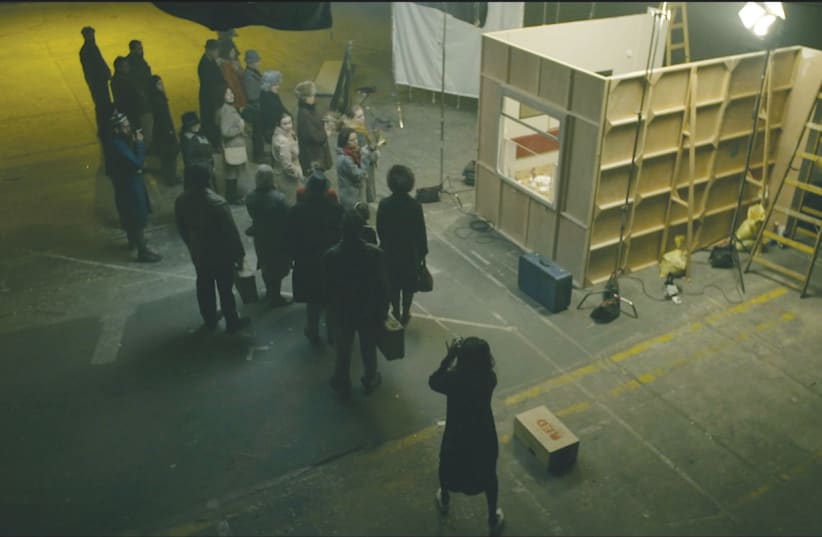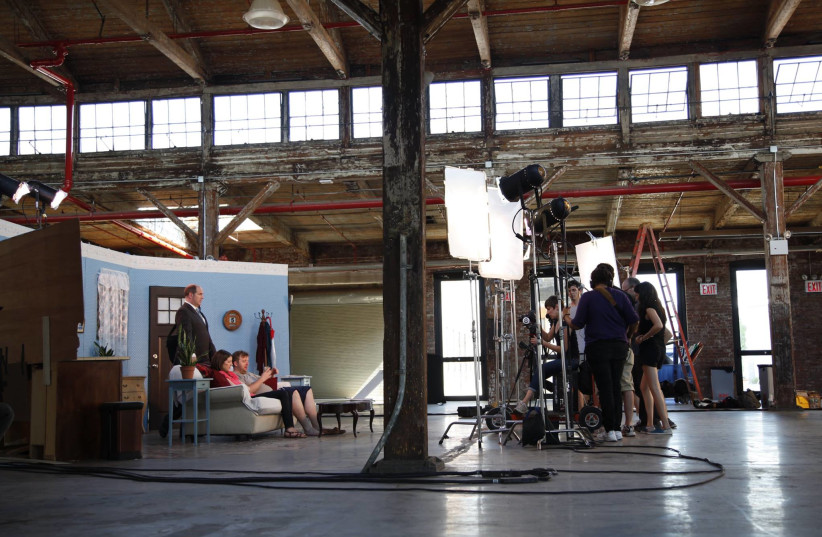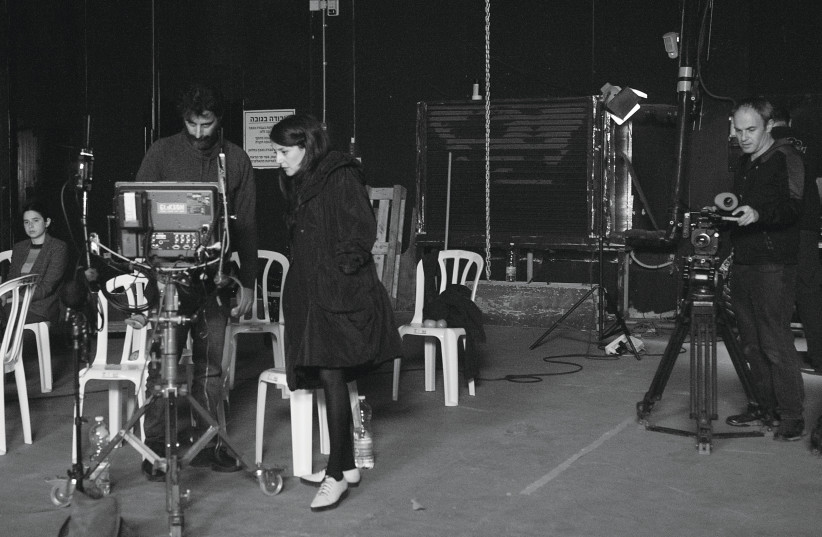"It takes four nights and three days to travel from Uzbekistan to Russia by train. In the winter of 1990, my family and I took that train, as we were emigrating from the Soviet Union,” says Ira Eduardovna in her two-channel installation The Iron Road, now on view at Tel Aviv Museum of Art. Eduardovna recreates the trip, triggering and reconstructing her memories as a 10-year-old girl, exposing her and her family’s emotions on that momentous journey.
Typically, in her artistic language, she uses repetition as a form of expression. The scenes are performed by professional actors, her family who immigrated to Israel, and herself. But as says in this interview, her work is not about immigration but emigration and everything that goes along with it.
The Iron Road is the second part of a trilogy and comes after On Foreign-Made Soles, presented in 2018 at the Israel Museum in Jerusalem. The third and final part, the name of which hasn’t yet been revealed, will close this chapter of her work.
Eduardovna, born in Tashkent, Uzbekistan (then part of the former Soviet Union), is an accomplished Israeli artist who has won numerous awards and held exhibitions in the US, Israel, and Europe. For 15 years she lived and worked in the US, where she earned gained a master of fine arts degree from New York’s Hunter College. Her works are of an autobiographical nature and explore the boundaries between video and architecture, examining issues of migration and displacement through non-linear storytelling.
‘The Iron Road,’ your new exhibition at the Tel Aviv Museum of Art, is a video installation about your family’s train journey before coming to Israel in 1990. Since then, you have lived in Israel and the United States for many years. In your art, you deal with issues of emigration, so let’s start with the question Where are you from?
I was born in Uzbekistan when it was still part of the Soviet Union. Then I lived in Israel for about 17 years and in the United States (Los Angeles and New York) for 15 years, and now I am here. I had a child during COVID, so it pushed me to come [back] here.
In Israel, people often ask ‘Where are you from originally?’ How do you respond to that?
It’s a very good question. When I was in New York, I would do the whole spiel: ‘I am from Israel, but I was born in Uzbekistan.’ But now when people ask me where am I from, I say from Uzbekistan, because that is where I was born and raised.
If the conversation continues, I usually add that I lived in New York for many years. Up to 10 years ago, I was saying I was from the Soviet Union, but I slowly started to realize that my identity is from Uzbekistan. Although I am definitely Soviet because Uzbekistan during the Soviet Union and now are completely two different places.
Do you speak any Uzbek?
No, my first language was Russian; Uzbek I studied only for a year as a second language at school. And then we left.
In The Iron Road, you repeated day ‘Poyekhali’ (‘Let’s go!’) in Russian. You lived for only 10 years in a Russian-speaking country, but the language seems very important to you. Usually at the Tel Aviv Museum of Art, all the headlines and descriptions of art pieces are written in Hebrew, Arabic, and English. In the case of your exhibition, it is also in Russian. Was that on your request?
Yes, I also wanted to include the Russian audience. I asked for it to be in Russian as well because the piece is partially in Russian.
The story took place more than three decades ago. Why do you still focus on the process of your emigration?
I don’t know [laughs]. Every time I finish a piece, I say to myself that my next project will not be autobiographical, will not be heavy; it will be light and fun and will not be personal… But I can only be an artist that I can be.
Why do you want the audience to know your private matters?
This is my way of being the most honest in my artwork. Going all the way with it. At the beginning of my art practice, I was much more academic. It was much more about the structure, conceptual, a little dryer, and less emotional. But then I realized that when I go to museums, I am drawn to work that is emotional, that moves me. And it became important to me. About 10 years ago, I started using more cinematic tools that are about emotion, which I was which I was consciously not using before.
Your first work dealing with these personal issues and memory was The Library Room.
Yes, it was my breakthrough piece. It was the work in which I established my visual language. I did it in 2009, when I was still a student at graduate school, at Hunter College, but I was already showing my work and I was a practicing artist.
In that piece, I filmed my family members packing a suitcase at the domestic library. I filmed the narrative five separate times, instead of at once with five cameras, and then combined and showed them together. That started my research on repetition and time; and multichannel installation.
What attracts you to the multichannel?
Fragmentations of memory. It is always in fragments, it’s never a full story. It is not linear. And I think multichannel for me is the best way of showing it.
Repetition became your brand mark. Also in the current work, The Iron Road, you repeat words and visual frames, stills.
It is true in each of my works. But only recently, when I started to study healing techniques, I realized that in overcoming trauma, repetition of a story, over and over, is part of the healing. Talking to a therapist, you make a trauma just a normal memory. I use these repetitive motifs in my work.
You are going over not just your own experiences but also your family’s. How does your family feel about your exposing their experiences and feelings? How did you convince them to do it?
They actually really love it. My sister (three years older) is a filmmaker, so my parents are kind of used to it, that our lives and art are combined. My mother is originally a fashion designer and my father is a mathematician, but he is also an artist inside. They enjoy the process. For them, it is also a healing experience. This is a very special time for us, as a family when we do it. They often ask me, ‘When is the next time?’
In The Iron Road, we see your mother on the set. Is she always there?
Yes, my parents are always on the set. Once my brilliant cinematographer, Avner Shahaf, noticed (it was not planned by me) that my mom, while watching the actress performing her, said: ‘It is too moving, I have to leave,’ and she started crying. I put that moment in the piece…
Why did your parents leave the Soviet Union?
Because it was not good there, and the gates were open. The first people who could leave were Jews because you could only leave if you received an invitation from a foreign country; Jews received invitations as refugees. And that immediately caused antisemitism.
I didn’t grow up feeling any resentment for being Jewish, but the moment we were allowed to leave, all of a sudden there were those voices that were pushing us out: ‘Go to your Israel, to your Jewish land.’ It was kind of harsh.
What does it mean for you the term ‘the iron road’?
‘Iron road’ is a literal translation of ‘railroad’ in Russian. But I think it also corresponds with the Silk Road, as Uzbekistan is on the Silk Road. And, of course, the Iron Curtain.
When I was watching the video, I noticed that you didn’t mention Israel or the word ‘Jewish’ in it. I felt like your story was about leaving, about emigration, not immigration.
Yes, because I wanted it to be open to every experience of emigration, not only this specific experience. Yes, it is about the departure, not about the arrival. I am interested in emigration in general. Even at the opening [at the Tel Aviv Museum of Art], people who came from England or the US told me that The Iron Road resonated with them.
In the video, you repeat that there was no way back. It really was a one-way ticket…
Yes, we could not go back… And we booked the full train car just for our family because there were stories of people being robbed, mobbed, and killed on the way to Moscow. Maybe they were just stories, but just in case, there was always someone who had to watch over those who were sleeping. They locked it, and we had the whole car to ourselves.
So you were like in a cage during this trip… There is a scene where you say that you saw your grandmother’s hands; but she wasn’t there. Could you please elaborate?
A lot of my work questions the validity of memory, both personal and collective. Questioning constantly what is true and what is not. That actually did happen. I remembered the scene of my grandmother reaching her hands to the window, and I lived with that memory for about 28 years.
Then, when I was describing the piece to my mom, she told me that my grandmother didn’t come with us, that I probably remembered somebody else…
My grandmother couldn’t come with us; it was too hard for her emotionally. At that point, I thought I would never see her, again. She joined us a year later; but [in 1990], we thought it was goodbye forever.
How much of your actors’ stories are incorporated into your work? Did they also move to Israel?
Yes, all of them, and I give them room. I am in a dialog with actors and actresses in rehearsals. I ask them to say [lines] in their own words.
Your words in the installation are ‘You will regret this; you will be sorry; you will have heavy experiences.’ But you are a successful artist; your exhibitions are in the most important museums and galleries. Are there any good stories that came out of the move?
I must say, I don’t regret it and I am extremely grateful to my parents all the time for getting out of the Soviet Union. But for new immigrants, like my grandmother, it was very hard at the beginning.
In addition to the installation, there is a book with your drawings.
The book I started as the storyboard for the piece. But it slowly made it to a sort of artist’s book, a graphic novel. A separate thing.
And it is very interesting in itself. But something also deeply related to the storyline is the music in your installation. I found the sound of drums very powerful. What was the process of adding music?
I worked with a friend of mine, the very talented composer Yuval Semo. I uploaded a video, and he recorded the music live. The concept was thought out beforehand, with the scene of my grandmother playing on a drum. The drum is also the sound of the train, so it was clear that a drum would be the main sound. The process was very organic.
The Iron Road is the second part of your trilogy. In the first part, On Foreign-Made Soles, shown in 2018 at the Israel Museum, Jerusalem, you ‘visited’ your childhood room in Uzbekistan.
The actress acted in the story based on my fantasies of going back home. She knocked at the door saying, ‘Hi, my name is Ira. I lived here when I was 10. Could I please take a look?’ So one actress does that, and on the second channel, you can see me directing her. And after the scene is done, another actress comes to the stage; there is the same scene, the same action, but now the actress plays me as the director.
Your work is sometimes compared to the matryoshka doll.
Yes, because new actresses are constantly being introduced; actresses acting actresses, and so on; from two, to four, to six.
What will we experience in the last piece of your trilogy? What will it be called?
I am working on it currently and don’t want to reveal the name yet...
Therefore, moving away from Uzbekistan, what are your first memories of Israel when you came here as a 10-year-old girl?
We came here in the middle of the winter and it was really warm, 20 degrees Celsius. It was beautiful, palm trees, and so many oranges. But unfortunately, two weeks later there was the Gulf War, so my arrival in Israel is remembered as the war. It was a shock. I was asking, ‘Why did we come here if it is a war zone? Why are we here?’
Not a soft landing. What did you know about Israel before coming here?
Nothing. We had one uncle who was already here, and he would write it’s sunny, there is a beach... [Apart from the war] I have another memory of Israel. The second day, my aunt took us to a supermarket. I remember standing in front of those colorful plastic bags, not knowing what was in them but knowing that there was so much stuff! I was overwhelmed by this.
I was told it was a regular store, but to me it was mind-blowing! In the Soviet Union in the 1980s, there was perestroika; there was no food in the stores, and there was poverty. I remember waiting in long lines with my mom to get bread or milk… And all of a sudden, this abundance over here!
Speaking of childhood, you once said an interesting thing about the language. You said that you speak fluent Hebrew but you don’t know the names of the birds and the trees because that is something one learns as a child.
I lack everything you learn as a child. All the cultural references. I don’t have any accent in Hebrew, but I don’t know the meaning of some terms, which confuses people. When I moved here, for the first few years I had only Russian-speaking friends, I watched Russian TV, read Russian books, listened to Russian music.
It sounds like you lived in a Russian ghetto.
Russian ghetto, absolutely!
When was the moment when you started to feel Israeli?
When I started studying art. For me, it was the moment of feeling a sense of belonging for the first time. Thanks to the art community, and the artists, I started to feel that I belonged in Israel. I was 19 years old. I think up to that point, I was in the Russian ghetto, in a closed community. Once I started to study art, I allowed myself not to be in it anymore.
But looking at your work, it seems like it is constantly on your mind.
Yes. Actually, I am working on a feature film, as scriptwriter and director, about the Russian teenagers in Israel in the 1990s. It’s based on everything that was happening around me in that Russian ghetto.
As you mentioned, you spent 15 years of your adult life in the US. How different was that?
There I was not an emigrant. I was an expat. After I finished my studies, I went traveling for almost two years. I went to the US and to South America. I was making videos and traveling and occasionally working here and there. And at the end, I met an Israeli filmmaker living in Los Angeles, who is currently my partner. And we live in Tel Aviv now.
Wrapping our set, what would you like people to take from your installations?
I want people to understand the complexity of the experience of emigrants. I think the installments are the voice of the identity of an emigrant. For me, it is important that voice be heard.
The Iron Road is on view at the Tel Aviv Museum of Art through December 2. For more information, see tamuseum.org.il/en/exhibition/ira-eduardovna-iron-road.














